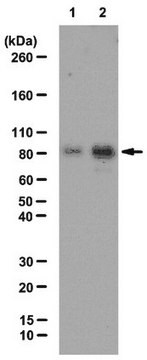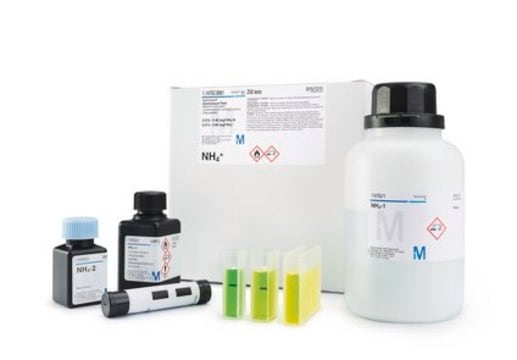General description
Src substrate cortactin (UniProt: Q14247; also known as Amplaxin, Oncogene EMS1) is encoded by the CTTN (also known as EMS1) gene (Gene ID: 2017) in human. Cortactin is an F-actin binding protein that localizes to the cell cortex and contributes to the organization of the actin cytoskeleton and cell shape. It plays a role in the formation of lamellipodia and in cell migration and is considered to be important in the regulation of neuron morphology, axon growth and formation of neuronal growth cones. It is widely expressed in most adherent cells and is a prominent substrate of protein-tyrosine kinase Src in vivo and in vitro. Cortactin contains multiple amino-terminal tandem repeats of a unique 37-amino acid sequence, which associates with actin, and a Src homology 3 (SH3) domain at the carboxyl terminus. Cortactin is shown to shuttle between the cytoplasm and the nucleus under basal conditions and the acetylated form is mainly localized to the nucleus. It has two putative nuclear export sequences, NES1 and NES2, in the SH3 region. Acetylation of cortactin by histone acetyltransferase p300 reduces cell migration by inhibiting the binding of cortactin to Kelch-like ECH-associated protein 1 (Keap1). Cortactin is deacetylated by various proteins, including histone deacetylase 6 (HDAC6). Treatment with trichostatin and nicotinamide is reported to increases in the acetylation of cortactin in the presence of leptomycin B. In cells stimulated with growth factors, HDAC6 translocates together with cortactin to the cell periphery where HDAC6 deacetylates cortactin, leading to enhanced cortactin binding to F-actin and thereby stimulating cell migration. Cortactin can be phosphorylated on multiple tyrosine and serine/threonine residues in cells stimulated by numerous agents, including several growth factors. Tyrosine phosphorylation occurs primarily on Y421 and Y466 that are located within the proline-rich domain. Multiple serine residues are shown to be phosphorylated by PAK1, PAK3, MAP kinases, and protein kinase D. (Ref.: Ito, A., et al. (2015). Sci. Signal. 8(404):ra120; MacGrath, SM and Koleske, AJ (2012). J. Cell Sci. 125(7): 1621-1626)
Specificity
This polyclonal antibody specifically detects Src substrate cortactin acetylated on Lysine 309.
Immunogen
KLH-conjugated linear peptide corresponding to 14 amino acids surrounding acetylated lysine309 of human Src substrate cortactin.
Application
Research Category
Cell Structure
This rabbit polyclonal Anti-Acetyl Cortactin (Lys309), Cat. No. ABT1378 detects Src substrate cortactin and is tested for use in Immunofluorescence and Western Blotting.
Western Blotting Analysis: A 1:500-2000 dilution from a representative lot detected Acetyl Cortactin (Lys309) in transfected HEK293T cell lysates & Trichostatin and Nicotinamide treated COS-7 cells (Courtesy of Dr Minoru Yoshida at RIKEN).
Western Blotting Analysis: A representative lot detected Acetyl Cortactin (Lys309) in transfected COS-7 cells (Ito, A., et. al. (2015). Sci Signal. 8(404):ra120).
Immunofluorescence Analysis: A representative lot detected Acetyl Cortactin (Lys309) in COS-7 cells treated with or without Trichostatin and Nicotinamide (Ito, A., et. al. (2015). Sci Signal. 8(404):ra120).
Quality
Evaluated by Western Blotting in treated COS7 cells.
Western Blotting Analysis: A 1:1,000 dilution of this antibody detected Src substrate cortactin in lysates from COS-7 cells stimulated with Trichostatin (1 mM) and Nicotinamide (5 mM).
Target description
~70 kDa observed; 61.59 kDa calculated. Uncharacterized bands may be observed in some lysate(s).
Physical form
Affinity Purified
Format: Purified
Purified rabbit polyclonal antibody in PBS without azide with 50% glycerol.
Storage and Stability
Stable for 1 year at -20°C from date of receipt.
Handling Recommendations: Upon receipt and prior to removing the cap, centrifuge the vial and gently mix the solution. Aliquot into microcentrifuge tubes and store at -20°C. Avoid repeated freeze/thaw cycles, which may damage IgG and affect product performance.
Other Notes
Concentration: Please refer to lot specific datasheet.
Disclaimer
Unless otherwise stated in our catalog or other company documentation accompanying the product(s), our products are intended for research use only and are not to be used for any other purpose, which includes but is not limited to, unauthorized commercial uses, in vitro diagnostic uses, ex vivo or in vivo therapeutic uses or any type of consumption or application to humans or animals.






